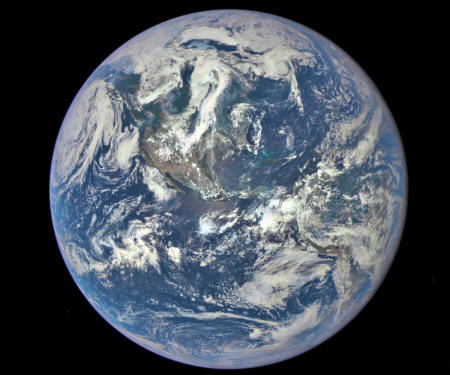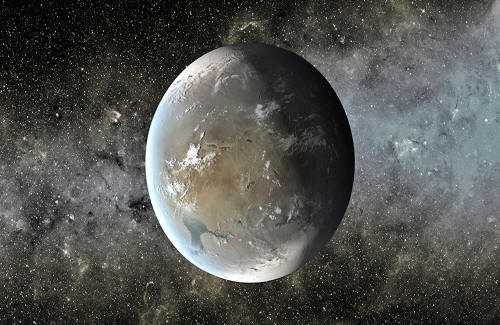A team of astronomers suggests
that
an exoplanet named
62f
could be habitable.
Kepler data suggests that 62f is
likely a rocky planet, and could have oceans. The exoplanet
is 40% larger than Earth and is 1200 light years away.
62f is part of a planetary
system discovered by
the Kepler mission in 2013. There are 5
planets in the system, and they orbit a star that is both
cooler and smaller than our Sun.
The target of this
study, 62f, is the outermost of the planets in the
system. Kepler can't tell us if a planet is habitable or
not. It can only tell us something about its potential
habitability.
The team, led by Aomawa
Shields from the UCLS department of physics and
astronomy, used different modeling methods to determine if
62f could be habitable, and the answer is... maybe.
Video Transcript:
Source
I am in search of another planet in the
universe where life exists.
I can't see
this planet with my naked eyes or even
with the most powerful telescopes we
currently possess. But I know that it's
there. And understanding contradictions
that occur in nature will help us find
it.
On our planet, where there's water,
there's life. So we look for planets
that orbit at just the right distance
from their stars.
At this
distance, shown in blue on this diagram
for stars of different temperatures,
planets could be warm enough for water
to flow on their surfaces as lakes and
oceans where life might reside.
Some
astronomers focus their time and energy
on finding planets at these distances
from their stars. What I do picks up
where their job ends. I model the
possible climates of exoplanets.
And here's
why that's important: there are many
factors besides distance from its star
that control whether a planet can
support life.
Take the planet Venus. It's named after
the Roman goddess of love and beauty,
because of its benign, ethereal
appearance in the sky. But spacecraft
measurements revealed a different story.
The surface temperature is close to 900
degrees Fahrenheit, 500 Celsius.
That's hot
enough to melt lead. Its thick
atmosphere, not its distance from the
sun, is the reason. It causes a
greenhouse effect on steroids, trapping
heat from the sun and scorching the
planet's surface.
The reality
totally contradicted initial perceptions
of this planet. From these lessons from
our own solar system, we've learned that
a planet's atmosphere is crucial to its
climate and potential to host life.
We don't know what the atmospheres of
these planets are like because the
planets are so small and dim compared to
their stars and so far away from us.
For example,
one of the closest planets that could
support surface water - it's called
Gliese 667Cc
- such a glamorous name, right, nice
phone number for a name - it's 23 light
years away.
So that's
more than 100 trillion miles. Trying to
measure the atmospheric composition of
an exoplanet passing in front of its
host star is hard. It's like trying to
see a fruit fly passing in front of a
car's headlight. OK, now imagine that
car is 100 trillion miles away, and you
want to know the precise color of that
fly.
So I use computer models to calculate
the kind of atmosphere a planet would
need to have a suitable climate for
water and life.
Here's an artist's concept of the planet
Kepler-62f, with the Earth for
reference. It's 1,200 light years away,
and just 40 percent larger than Earth.
Our NSF-funded work found that it could
be warm enough for open water from many
types of atmospheres and orientations of
its orbit.
So I'd like
future telescopes to follow up on this
planet to look for signs of life.
Ice on a planet's surface is also
important for climate. Ice absorbs
longer, redder wavelengths of light, and
reflects shorter, bluer light. That's
why the iceberg in this photo looks so
blue. The redder light from the sun is
absorbed on its way through the ice.
Only the
blue light makes it all the way to the
bottom. Then it gets reflected back to
up to our eyes and we see blue ice. My
models show that planets orbiting cooler
stars could actually be warmer than
planets orbiting hotter stars.
There's
another contradiction - that ice absorbs
the longer wavelength light from cooler
stars, and that light, that energy,
heats the ice.
Using climate models to explore how
these contradictions can affect
planetary climate is vital to the search
for life elsewhere.
And it's no surprise that this is my
specialty. I'm an African-American
female astronomer and a classically
trained actor who loves to wear makeup
and read fashion magazines, so I am
uniquely positioned to appreciate
contradictions in nature...
...and how they can inform our search
for the next planet where life exists.
My organization,
Rising Stargirls,
teaches astronomy to middle-school girls
of color, using theater, writing and
visual art.
That's
another contradiction - science and art
don't often go together, but
interweaving them can help these girls
bring their whole selves to what they
learn, and maybe one day join the ranks
of astronomers who are full of
contradictions, and use their
backgrounds to discover, once and for
all, that we are truly not alone in the
universe.
Thank you.
According to the study, much of
62f's potential habitability revolves around the CO2
component of its atmosphere, if it indeed has an atmosphere.
As a greenhouse gas, CO2
can have a significant effect on the temperature of a
planet, and hence, a significant effect on its habitability.
Earth's atmosphere is only 0.04% carbon dioxide (and
rising.)
Kepler-62f
would likely need to have
much more CO2 than that if it were to
support life. It would also require other atmospheric
characteristics.
The study modeled parameters for
CO2 concentration, atmospheric density,
and orbital characteristics.
They simulated:
-
An atmospheric thickness
from the same as Earth's up to 12 times thicker.
-
Carbon dioxide
concentrations ranging from the same as Earth's up
to 2500 times Earth's level.
-
Multiple different
orbital configurations.
It may look like the study casts
its net pretty wide in order to declare a planet potentially
habitable. But the simulations were pretty robust, and
relied on more than a single, established modeling method to
produce these results.
With that in mind, the team
found that there are multiple scenarios that could make 62f
habitable.
"We found there are multiple
atmospheric compositions that allow it to be warm enough
to have surface liquid water," said Shields, a
University of California President's Postdoctoral
Program Fellow.
"This makes it a strong
candidate for a habitable planet."

Our dear,
sweet Earth is the only planet
where life is confirmed (by
us, the humans...)
Here it is,
as seen on July 6, 2015
from a distance of one million miles
by a NASA
scientific camera aboard
the Deep Space Climate Observatory
spacecraft.
Credits: NASA
As mentioned earlier, CO2
concentration is a big part of it.
According to Shields, the
planet would need an atmospheric entirely composed of CO2,
and an atmosphere five times as dense as Earth's to be
habitable through its entire year.
That means that there would be
2500 times more carbon dioxide than Earth has.
This would work because the
planet's orbit may take it far enough away from the star for
water to freeze, but an atmosphere this dense and this high
in CO2 would keep the planet warm.
But there are other conditions
that would make 62f habitable, and these include the
planet's orbital characteristics.
"But if it doesn't have a
mechanism to generate lots of carbon dioxide in its
atmosphere to keep temperatures warm, and all it had was
an Earth-like amount of carbon dioxide, certain orbital
configurations could allow Kepler-62f's surface
temperatures to temporarily get above freezing during a
portion of its year," said Shields.
"And this might help melt
ice sheets formed at other times in the planet's orbit."
Shields and her team used
multiple modeling methods to produce these results.
The climate was modeled using
the
Community Climate System Model and the
Laboratoire de
Meteorologie Dynamique (LMD)
generic model. The planet's orbital
characteristics were modeled using
HNBody.
This study represents the first
time that these modeling methods were combined, and this
combined method can be used on other planets.
Shields said,
"This will help us
understand how likely certain planets are to be
habitable over a wide range of factors, for which we
don't yet have data from telescopes.
And it will allow us to
generate a prioritized list of targets to follow up on
more closely with the next generation of telescopes that
can look for the atmospheric fingerprints of life on
another world."
There are over
2300
confirmed exoplanets, and many more candidates yet to be
confirmed.
Only a handful of them have been
confirmed as being in the habitable zone around their host
star. Of course, we don't know if life can exist on other
planets, even if they do reproduce the same kind of
habitability that Earth has.
We just have no way of knowing,
yet.
That will change when
instruments like the
James
Webb Space Telescope are able to peer into the
atmospheres of exoplanets and tell us something about any
bio-markers that might be present.
But until then, and until we
actually visit another world with a probe of some design, we
need to use modeling like the type employed in this study,
to get us closer to answering the question of life on other
worlds.



